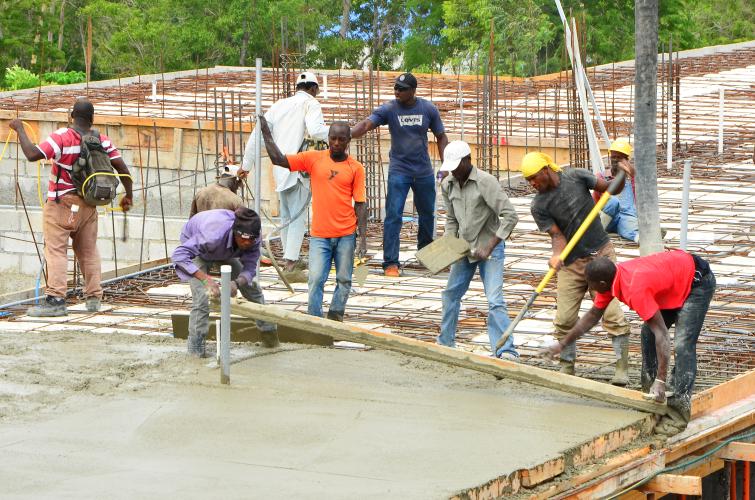“I am healthy, my baby is healthy, and I am happy to return to my home.”
Your donation will help support our maternal health program, ensuring mothers like Bernette can deliver their babies safely.


“N ap avanse! We are heralding a new era at St. Boniface Hospital,” Payette Architecture says. “Upon completion, it will be the only guaranteed 24/7 emergency obstetric care and neonatal intensive care for the entire Southern Peninsula in Haiti.”
Seven months into the project, we are well on our way to realizing the vision of offering high-quality maternal health care. The new HEI/SBH Maternal Health Center now has a roof. The July 29th low roof pour was successful thanks to the efforts of Build Health International (BHI) and their dedicated team of Haitian employees. The BHI team consisted of 25 people including masons, laborers, CINA workers, assistant supervisors, an engineer, and a construction manager. They mixed and poured 1000 bags of concrete over the course of 20 hours to complete the roof. They overcame a number of challenges that would have caused serious complications for a less experienced or devoted team.
The crew woke up early to begin pouring and discovered that the conveyer belt on the volumetric truck was jammed. After fixing the equipment, they began pouring concrete at 7 a.m. The Maternal Health Center roof is built to meet modern earthquake and hurricane standards. Originally slated to be a high pitched roof of steel joists, the decision was made shortly after construction began to instead utilize a flat concrete ribbed roof to better protect against relatively frequent Category 3, 4, and 5 hurricanes. The new design calls for a “low roof” that covers all but the pathology and postpartum rooms. Those will be covered by a “high roof,” which provides a well-lit and more open atmosphere.
There’s always difficulty working in Haiti with weather, equipment, and materials. Our success last night was possible thanks to the group of guys we were working with, who were willing to work from seven in the morning until three in the morning when it was cold and raining.
Erik Benson, Senior Construction Manager
Pouring of the low roof continued throughout the day. Midway through the pour, the backhoe got a flat tire. This brought pouring to a standstill because the backhoe is used to refill the mixing truck with the sand and gravel it uses to create concrete. The workers scrambled to replace the tire, racing against time as the concrete began to harden in the hydraulic arm of the pump truck—a disaster that would require completely disassembling the pump mechanism to clean, likely extending the roof pour into the next day.
They replaced the tire in time and began pumping again. Night fell and the BHI workers set up spotlights, laboring on. The Fond des Blancs region hasn’t seen significant rain in months and the water well is running low. Both the hospital and residence have encountered frequent water shortages. BHI chose to draw water from a separate cistern and supplemented this supply by sending trucks to Degue, a local town, to bring additional water. However, as night fell, low water levels forced them to begin pumping from the well. The hours passed tensely; the water supply dropped precipitously as the concrete slowly filled out the roof.
Suddenly, two potentially devastating problems occurred. The pump truck stopped pumping, crippled by an electrical problem, and a thunderstorm hit. The truck operators worked quickly to resolve the issue as lightning illuminated the sky. Rain pelted down onto the newly poured concrete. The team moved quickly to cover the most freshly poured section of the roof with sheets of plastic. While water helps prevent drying concrete from cracking, it can cause structural problems when too much is mixed with still-wet concrete.
The rain fell hard for 15 minutes, but a light rain continued and persisted over the course of an hour. Meanwhile, the concrete in the pump truck was again threatening to dry in the tubing of the hydraulic arm. The truck operators still couldn’t find the source of the electrical problem. Thankfully, visiting do-it-all handyman Sid Clinton, a former NASA IT specialist, lent his expertise and was able to resolve the problem, preventing the concrete from solidifying and causing a time-consuming setback.
The team began pumping again. At 10 p.m., two-thirds of the roof had been poured. The water supply held up and they labored through the night. The roof was completed at 3 a.m. Early the next morning, sun glinted off of the new and pristine Maternity Health Center roof, which will allow SBH to provide health care to women and children who have nowhere else to turn for years to come.
The hard work of BHI and their local Fond des Blancs employees was critical to the success of this operation. Their willingness to confront the immense challenges of construction in rural Haiti will enable life-saving care for the underserved of the Southern Peninsula. Inspired by our partners at BHI, the HEI/SBH staff will continue to persevere in the same way to realize the right to health of our friends, family, and neighbors in the Fond des Blancs area.
Your donation will help support our maternal health program, ensuring mothers like Bernette can deliver their babies safely.
